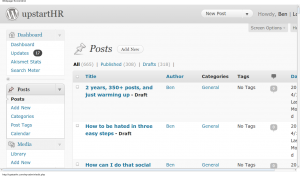 Disengaged employees cost companies money in numerous ways. They are much more expensive to maintain than their engaged counterparts, and many organizations are working hard to find ways to help get their people engaged and more productive.
Disengaged employees cost companies money in numerous ways. They are much more expensive to maintain than their engaged counterparts, and many organizations are working hard to find ways to help get their people engaged and more productive.
I’ve been a disengaged employee. It stinks.
I didn’t start out planning to be one. I don’t know that anyone sets their life goal as becoming a disengaged employee, but there are more of them in the workforce than we would like to admit. Here’s my story as a cautionary tale. You can turn an enthusiastic, engaged person into a disengaged, discouraged one with time.
The bright, beautiful beginning
I was excited. I was beyond pumped. I was going to knock this job out of the park. I had been researching ideas weeks before I started the job. I had a list of things I wanted to streamline and improve. I was going to make a difference and impact the organization in a big way.
And then it happened. Not suddenly. There was no explosion or flash of light. I just sort of noticed it, kind of like when you see something from the corner of your eye. It was the beginning of the end.
Where good employees go to die
You know when you start something new you can only see the good things? You see how everything works well and the positive aspects of every little detail. And then as time goes on you start to realize that there are problems, but hey, everyone has some, right? No company is perfect. And eventually those problems accumulate until they block out all else and you finally come to realize that no matter how much you do or care about your work, it doesn’t matter in the big scheme of things. I looked up one day and realized:
- I wasn’t getting any coaching or support from my manager.
- Our executive leadership was incompetent.
- Much of the workforce was unappreciated, including me.
- Fresh, new ideas? They were disregarded or ignored. Why put in extra effort for ridicule or lack of acknowledgement?
- Some of the work I was asked to do did not contribute to the organization in any meaningful way. But it was “essential” that it was completed “like we always have done it.” The best part? When the department went into a manpower crunch, some of the work just stopped being done with no discernible impact. When that happened all I could think was how many hours I had spent wasting time on something that nobody even cared about.
- Other than the executive team, nobody had much of an idea of the overall strategy or direction of the organization. It’s hard to focus your efforts to support that when you don’t know where you’re going.
- Turnover for the positions that made up about 75% of our staff was in the 50% range annually.
If that is disheartening for you to read, I can promise you that it’s much, much worse to live it out in person. But don’t you worry, I’ve come a long way since then and now work for a company that makes the other one, for lack of a better term, look like a pile of manure. My company’s culture and engaged workforce is one that other CEOs dream about.
A glimpse of “the good life”
Notice how much different these aspects are from the list above. The difference is astounding!
- My manager coaches and supports me on a daily basis.
- The executive team is open, honest, and highly connected at all levels of the organization.
- Our people are appreciated and rewarded in many ways (monetary and not) for their efforts.
- Ideas? We have a special database set up to capture them. Even ones that might not fit currently can be deferred until a later date.
- You can see a direct impact that your efforts have on the company’s direction and mission. Even in the HR/operations role I hold, that’s still true.
- Everyone has an idea and grasp of the strategy and mission of the company, and the leadership team readily shares information as it comes out about new victories and opportunities.
- Turnover… We’ve had two people voluntarily leave to go work elsewhere in the history of the company. Telling, huh?
After my experiences, I know one thing for sure. Engagement isn’t easy if you don’t already have it. It’s not about setting up a program or getting your CEO to agree to support you. I’ll talk more about what engagement looks like soon enough. I’m reading Carrots and Sticks Don’t Work by Dr. Paul Marciano. It’s an excellent book and I plan to review it soon, but I read something today about the qualities of a disengaged employee and it brought on the idea for this post. If you haven’t read the book, you are missing out. Big time.
By the way, if you haven’t seen it, check out this free eBook on employee engagement. Feel free to download, print, or just read it on your computer.


